Eunice Foote: The Nearly-Forgotten "Mother of Climate Science"
Hidden Voices began as a collaboration with the Museum of the City of New York to help City students learn about the countless individuals who are often “hidden” from traditional historical records. Each of the people highlighted in this series has made a positive impact on their communities while serving as outstanding examples of leadership, advocacy, and community service.
Today, we're sharing the story of Eunice Newton Foote, a groundbreaking amateur scientist, inventor, and women’s rights activist who today is widely considered to be the first person to discover the greenhouse effect, though her work was overlooked for many years.
In 1859, an Irish physicist named John Tyndall conducted a series of experiments in which he passed radiant heat through various gases, including carbon dioxide and water vapor, to demonstrate how these gases trapped heat in the Earth’s atmosphere. The results of those experiments would later serve as the cornerstone of our understanding of climate change. His research earned him widespread recognition in the scientific community at the time. Today, Tyndall is often credited as the “father” of climate science, with his groundbreaking findings often cited as the beginning of the study of greenhouse gases.
For over a century, Tyndall was considered the discoverer of the greenhouse gas effect, and prominent scientific institutions that are dedicated to studying climate science bear his name. But in 2011, this widely accepted belief was turned on its head. It was in that year when a man named Raymond Sorenson—an avid collector of old scientific journals and manuscripts—happened to be leafing through a volume of The Annual of Scientific Discovery published in 1857 and first read the name Eunice Foote.
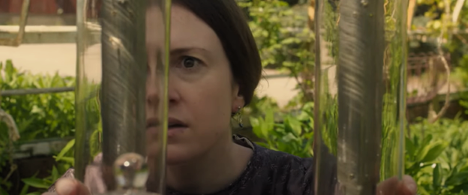
Foote, as Sorenson would discover, had been conducting her own experiments—three years before Tyndall—demonstrating the same phenomenon that Tyndall would later claim to have discovered.
Using a simple setup—glass cylinders filled with different gases and equipped with thermometers—Foote tested how various gases responded to sunlight. The results were striking: she found that carbon dioxide, in particular, absorbed heat more effectively than other gases. The cylinder containing carbon dioxide warmed much more than those filled with regular air, and it also took longer to cool down once removed from the sun.
Foote’s conclusion was groundbreaking: she suggested that gases like carbon dioxide and water vapor could trap heat in the atmosphere, raising the temperature of the Earth. She concluded, “An atmosphere of that gas would give to our Earth a high temperature… and if as some suppose, at one period of its history the air had mixed with it a larger proportion than at present, an increased temperature…must have necessarily resulted.” This was a pivotal scientific discovery, as Foote was the first person to demonstrate that carbon dioxide is a greenhouse gas.
Sorenson, who had never heard of Foote prior to that moment, had seemingly made a discovery of his own: perhaps John Tyndall was not the person who discovered the greenhouse effect after all.
Academics began to research more about the life and work of the previously unknown woman, Eunice Foote, in an attempt to learn more, and to understand how her name—and the scientific discoveries she made—had remained hidden for so long.
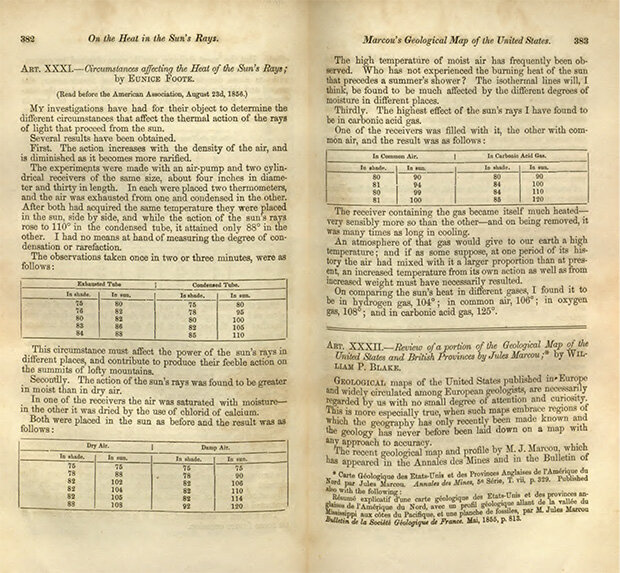
Born Eunice Newton in Goshen, Connecticut in 1819, Eunice’s upbringing in a large family was defined by both the challenges and opportunities of the early 19th century. Her father, Isaac Newton (not the same Isaac Newton as the famous physicist, although it is believed they were distant relatives), was a cattle runner, and the family frequently moved to find better opportunities. By the time Eunice was three years old, the family had relocated to Bloomfield, New York. Though it was somewhat uncommon at the time for a family like Eunice’s to have sent their daughters to school, her parents strongly valued education and they were determined to provide her with the best schooling available for girls at the time.
As she got older, Eunice attended the Troy Female Seminary—one of the first institutions in the United States to offer young women an education comparable to that of college-educated men. At the seminary, Eunice was not only taught the typical subjects for women of the time, but also had access to scientific courses and laboratory work. This opportunity gave her the skills and knowledge she would need to pursue her future scientific endeavors.
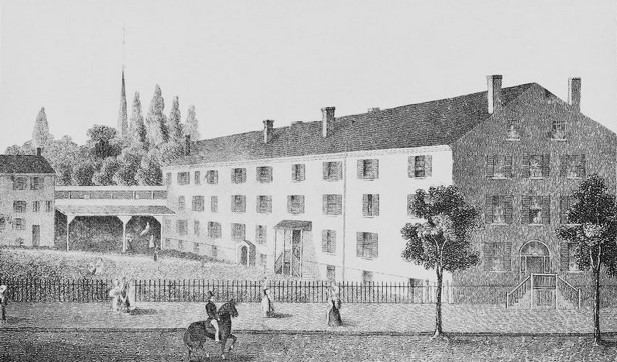
In 1841, Eunice married Elisha Foote, an inventor and lawyer who would go on to become the U.S. Commissioner of Patents, and the couple moved to Seneca Falls, New York. Both Foote and her husband had a passion for science and technology, and the pair frequently collaborated in trying to answer the scientific questions and problems that interested them, including in 1856: as Eunice was conducting her experiments on carbon dioxide, Elisha was engaged in similar studies.
Later that year, both Foote’s attended the Annual Meeting of the American Association for the Advancement of Science (AAAS) to present their findings. However, while Elisha presented his own work, Eunice’s paper was read by a male colleague, Joseph Henry, the first director of the Smithsonian Institution. It is uncertain whether this was because women were forbidden from presenting their own, or if it simply would have been unusual for her to do so. Regardless, Eunice being unable to speak for herself was a strong indication of the prevailing prejudices of the scientific community at the time against women in their field. Henry apparently alluded to this when he introduced Eunice’s work, remarking that “Science was of no country and of no sex. The sphere of woman embraces not only the beautiful and the useful, but the true.”
Foote’s research was published in the American Journal of Science later that year under the title “Circumstances Affecting the Heat of Sun's Rays,” a significant achievement for a woman scientist in the 19th century, alongside of Elisha’s paper. This is an important piece of evidence in a debate that continues amongst historians and scientists today surrounding the question of whether Tyndall knew about Foote’s work when he conducted his own experiments three years later.
Tyndall himself seemed quite sure that he was breaking new ground when he reported on his findings: “nothing, so far as I am aware,” he wrote, “has been published on the transmission of radiant heat through gaseous bodies." While we now know this was not accurate, scholars are divided as to the question of whether Tyndall was lying when he wrote this, or simply unaware.
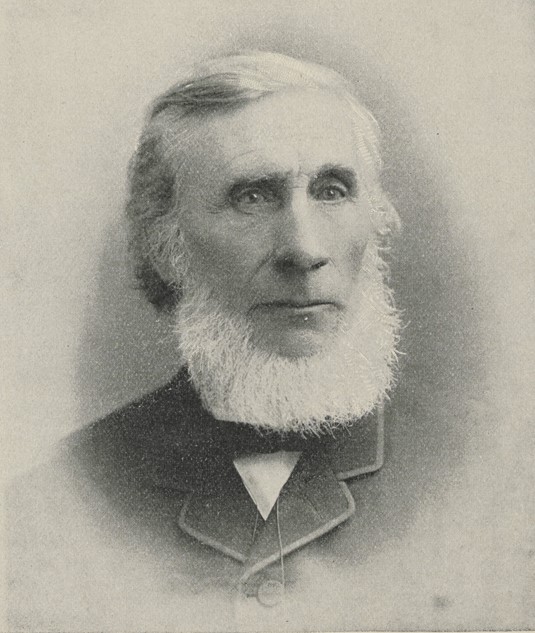
Roland Jackson, Tyndall’s biographer, contends that there is no direct evidence that Tyndall was aware of Foote’s work. Jackson argues that the scientific exchange between America and Europe was limited, and Tyndall’s research, conducted independently in England, was likely unaware of Foote's findings, which were not widely circulated in Europe.
Others take a different view, however. Professor John Perlin, for example, argues that Tyndall was likely aware of Foote's experiments, given the overlapping scientific communities of the time and the fact that Tyndall had access to the American Journal of Science, where Foote's paper was published. He points to the fact that Tyndall was an editor for Philosophical Magazine when the publication reprinted a paper by Elisha Foote—the one that was originally published right next to Eunice’s. Perlin believes this indicates it would have been unlikely for Tyndall to have seen and read Elisha’s paper without having seen Eunice’s as well. Tyndall was also known to have held biases against women’s participation and capability in science, adding to the list of reasons why he may have chosen not to credit Foote in his own paper, even if he was aware of her work.
Though it is an interesting debate, it is likely impossible to ever know the truth for certain. Nevertheless, Tyndall still deserves some credit for his own work: while Eunice Foote’s experiments demonstrated that carbon dioxide trapped more heat than other gases, she lacked the resources to explore why this happened. Tyndall’s experiments expanded on Foote's findings by using more advanced equipment and isolating infrared radiation as the key factor in the greenhouse effect. Tyndall’s research also provided a deeper understanding of how different gases, including water vapor, specifically interacted with radiant heat, marking a significant step forward in climate science.
However, it is difficult not to imagine what Eunice could have been, had she lived in a different time: clearly a bright scientific mind, Foote was nevertheless not able to become a professional scientist in the traditional sense. As an amateur, she lacked the resources needed to have conducted experiments like Tyndall’s, in addition to lacking the credibility of her professionally trained peers. Being a woman only exacerbated these issues, and as a result, her work was dismissed or ignored by many established scientists. Perhaps with more resources, education, and respect from the scientific community, her name would not have been lost to history for so long.
That is not to say Foote did not accomplish plenty, even within the confines that she existed in as a woman in the nineteenth century. By the time of her death in 1888, she had filed several patents, one in 1860, for a type of filling for footwear, designed to “prevent the squeaking of boots and shoes.” The second, patented in 1864, was for a machine designed to produce paper with stronger fibers. She also contributed to an invention patented under her husband’s name in 1842—the first thermostatically-controlled cook stove—credited solely to him in part because married women could not defend their patent rights at the time. In fact, of the tens of thousands of patents awarded between 1791 and 1864, only 70 were awarded to women; Eunice Foote was awarded two.
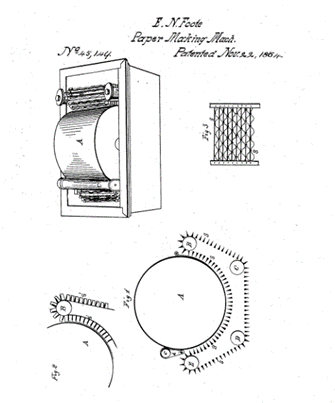
Eunice also helped pave the way for generations of women who would come after her. Living in Seneca Falls, a center for progressive political activity at the time, the Footes were connected to many of the better-known figures from the movements that emerged there. Elisha had learned law from Elizabeth Cady Stanton’s father, for example. It is perhaps unsurprising to learn, then, that Eunice attended the historic 1848 Seneca Falls Convention, where she was the fifth of 68 women to sign the Declaration of Sentiments. The Declaration was a document written by Cady Stanton and other suffragists that demanded equality for women in all aspects of life. The text echoes and expands on the U.S. Declaration of Independence: “We hold these truths to be self-evident; that all men and women are created equal.” Foote was also one of a smaller group of women who worked with Frederick Douglass—one of 32 men to sign, along with Elisha Foote, who also attended—to get the Declaration published in his newspaper.
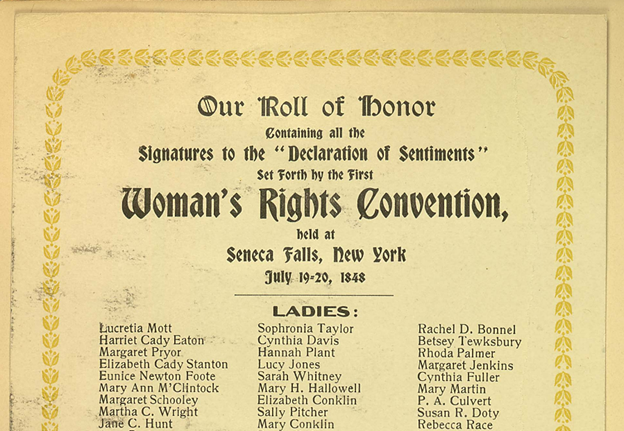
Her activism in the women’s rights movement was as important to her as her scientific endeavors, and both pursuits were closely intertwined. Women’s suffrage was an early step towards increased gender equality in all aspects of life—including in education and science. Yet, as accomplished as she was, Foote was still nearly erased from the historical record—a reminder that women have long played a critical role in shaping science, despite the challenges they have faced in being acknowledged for their discoveries.
Now, over 160 years later, Eunice Foote’s revolutionary contributions are finally being recognized for what they always were: a fundamental piece of the puzzle in understanding the warming of our planet. As scientists today face the growing challenges of combating climate change, it is crucial to remember the pioneers like Foote, whose work laid the groundwork for future generations.
Sources
- Abunyewa, A.M. (2023, January 21). Hidden Histories: Eunice Newton Foote: The Woman Who Discovered the Greenhouse Effect. Yale Scientific Magazine. https://www.yalescientific.org/2023/01/hidden-histories-eunice-newton-footethe-woman-who-discovered-the-greenhouse-effect/
- Brockell, G. (2021, November 17). Did The “Father of Climate Science” Steal His Discovery from Eunice Newton Foote? The Washington Post. https://www.washingtonpost.com/history/2021/11/17/eunice-newton-foote-john-tyndall/
- Foote, E. (1856). Circumstances Affecting the Heat of the Sun’s Rays. In The American Journal of Science and Arts: Vol. XXII. G.P. Putnam & Co. https://books.google.co.uk/books?id=6xhFAQAAMAAJ&pg=PA382#v=onepage&q&f=false
- Foote, E. (1864). Improvement In Paper-Making Machines (United States Patent US45149A). https://patents.google.com/patent/US45149A/en
- Garro, E. (Director). (2018, June). Eunice [Video recording]. https://www.youtube.com/watch?v=WxgAOKzOcBU
- Halley, C. (2019, December 17). How 19th Century Scientists Predicted Global Warming. JSTOR Daily. https://daily.jstor.org/how-19th-century-scientists-predicted-global-warming/
- Huddleston, A. (2019, July 17). Happy 200th Birthday to Eunice Foote, Hidden Climate Science Pioneer. Climate.gov. https://www.climate.gov/news-features/features/happy-200th-birthday-eunice-foote-hidden-climate-science-pioneer
- Hunt, B. (2020, June 30). Signer #5, Eunice Newton Foote: “The Climate Scientist.” 100 Signers Project. https://www.100signersproject.com/signer-profiles/signer-5-eunice-newton-foote-the-climate-scientist
- Jackson, R. (2019). Eunice Foote, John Tyndall and a Question of Priority. Notes and Records: The Royal Society Journal of the History of Science, 74(1), 105–118. https://doi.org/10.1098/rsnr.2018.0066
- Joosse, T. (2023, July 12). August 1856: Eunice Foote Concludes That Carbon Dioxide Could Warm the Atmosphere, Three Years Before John Tyndall Did. American Physical Society. https://www.aps.org/apsnews/2023/07/carbon-dioxide-atmosphere-eunice-foote
- Kurland, Z., & Hafner, K. (2023, November 9). The Woman Who Demonstrated the Greenhouse Effect [Broadcast]. Retrieved from https://www.scientificamerican.com/article/the-woman-who-demonstrated-the-greenhouse-effect/
- McNeill, L. (2016, December 5). This Suffrage-Supporting Scientist Defined the Greenhouse Effect but Didn’t Get the Credit, Because Sexism. Smithsonian Magazine. https://www.smithsonianmag.com/science-nature/lady-scientist-helped-revolutionize-climate-science-didnt-get-credit-180961291/
- Mitchell, J. (2018, May 10). Righting a Scientific Wrong. UCSB: The Current. https://news.ucsb.edu/2018/018985/righting-scientific-wrong
- Mitchell, N. (2018, July 14). The Father of Climate Science, My Foote!? A Mystery Revealed [Broadcast]. Retrieved from https://www.abc.net.au/listen/programs/sciencefriction/eunice-foote/9990850
- Our Roll of Honor. Listing women and men who signed the Declaration of Sentiments at first Woman’s Rights Convention, July 19-20, 1848 (JK1881 .N357 sec. XVI, no. 3-9 NAWSA Coll). (1908). Rare Book and Special Collections Division. https://www.loc.gov/resource/rbcmil.scrp4006701/
- Parry, J. (2019, March 21). Adrenaline Junkie [Review of The Ascent of John Tyndall: Victorian Scientist, Mountaineer and Public Intellectual, by R. Jackson]. London Review of Books, 41(06). https://www.lrb.co.uk/the-paper/v41/n06/jonathan-parry/adrenaline-junkie
- Perlin, J., & Regan, A. (2019, November). Eunice Foote to UCSB: A Story of Women, Science, and Climate Change. UC Santa Barbara Library. https://spotlight.library.ucsb.edu/starlight/eunice-foote-to-ucsb
- Resilience. (2019, July 30). A “Foote-Note” on the Hidden History of Climate Science: Why You Have Never Heard of Eunice Foote. Resilience. https://www.resilience.org/stories/2019-07-30/a-foote-note-on-the-hidden-history-of-climate-science-why-you-have-never-heard-of-eunice-foote/
- Santora, T. (2019, July 17). The Female Scientist Who Discovered the Basics of Climate Science—And Was Forgotten by History. https://www.audubon.org/news/the-female-scientist-who-discovered-basics-climate-science-and-was-forgotten
- Schwartz, J. (2020, April 21). Overlooked No More: Eunice Foote, Climate Scientist Lost to History. The New York Times. https://www.nytimes.com/2020/04/21/obituaries/eunice-foote-overlooked.html
- Science Knows No Gender: Eunice Newton Foote and the Cause of Global Warming. (2020, December 8). [Video recording]. New York State Archives. https://www.youtube.com/watch?v=t7-TxgB4vE8
- Scientific American. (1856, September 13). Scientific Ladies—Experiments with Condensed Gases. Scientific American, 12, 5. https://babel.hathitrust.org/cgi/pt?id=coo.31924080787660&view=1up&seq=9
- Sorenson, R. P. (2011). Eunice Foote’s Pioneering Research on CO2 And Climate Warming; #70092. Search and Discovery. https://www.searchanddiscovery.com/pdfz/documents/2011/70092sorenson/ndx_sorenson.pdf.html
- The Editors of Encyclopedia Britannica. (1999, April 26). Troy Female Seminary [Encyclopedia]. Encyclopedia Britannica. https://www.britannica.com/topic/Troy-Female-Seminary
- The Miriam and Ira D. Wallach Division of Art, Prints and Photographs: Print Collection, The New York Public Library. (1894). Professor John Tyndall. Retrieved from https://digitalcollections.nypl.org/items/36cde330-dcf3-0130-1e33-58d385a7b928
- Unknown. (1898). Troy Female Seminary, 1882 [Sketch]. Fairbanks, Mary J. Mason (Mrs. Abel W.) (1898). Emma Willard and her Pupils or Fifty Years of Troy Female Seminary 1822-1872. New York, New York: Margaret Olivia Slocum Sage. OCLC 6957648. https://commons.wikimedia.org/wiki/File:Troy_Female_Seminary,_1822.jpg
- Wells, D. A. (Ed.). (1857). Heat of the Sun’s Rays. In The Annual of Scientific Discovery, Or, Year-book of Facts in Science and Art for 1857 (Vol. 8, pp. 159–160). Gould, Kendall, and Lincoln. https://books.google.ca/books?id=xWAEAAAAYAAJ&pg=PA159&lpg=PA159#v=onepage&q&f=false
- Welsh, N. (2018, May 10). John Perlin Rediscovers Feminist Crusader Who Discovered Climate Change. The Santa Barbara Independent. https://www.independent.com/2018/05/10/john-perlin-rediscovers-feminist-crusader-who-discovered-climate-change/
- Wilkinson, K. (2019, July 17). Why History Forgot the Woman Who Discovered the Cause of Global Warming. TIME. https://time.com/5626806/eunice-foote-women-climate-science/

